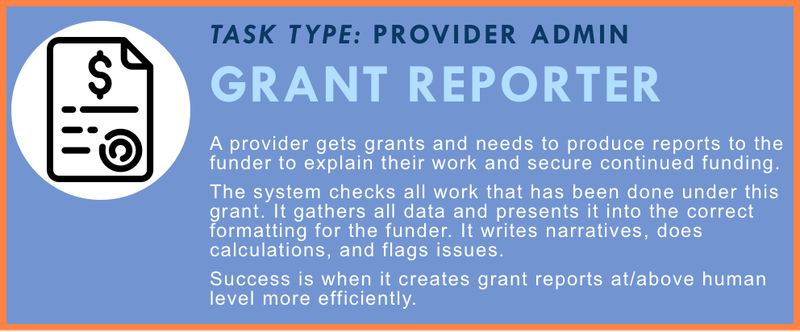Grant Reporter

Help providers generate complete, accurate grant reports by compiling data, writing narratives, and formatting results to meet funder requirements.
Task Description
Legal help and justice organizations rely on grant funding to deliver services—and those grants often come with detailed reporting requirements. Providers must regularly summarize what work was done, how clients were served, and what impact was achieved. These reports must be accurate, timely, and formatted according to funder specifications, often with a mix of narrative and quantitative data.
This task involves a system that acts as an automated grant reporting assistant. It connects to the provider’s service records, time logs, case management system, and project notes. It pulls relevant information tied to the specific grant (e.g., number of people served, case outcomes, types of legal issues addressed), and compiles it into the required report format. It performs calculations, flags data gaps, and drafts the narrative sections based on the work completed.
The system can handle varied funder templates (e.g., LSC, IOLTA, city or private foundation forms) and adjust the reporting language to align with the grant’s goals or required voice. It can track overlapping grants, prevent double-counting, and help staff make corrections before submission.
This is especially valuable for teams managing multiple concurrent grants or under tight reporting deadlines. It reduces the burden on program managers and attorneys while increasing consistency, audit-readiness, and clarity in what’s being reported.
Success means the provider receives a funder-ready grant report with minimal manual effort—meeting or exceeding the quality of a carefully written human-generated report, while saving significant staff time.
How to Measure Quality?
📊 Data Accuracy and Completeness
- Pulls correct case counts, service types, staff time, and outcomes from internal systems
- Follows grant-specific definitions and counting rules (e.g., “case closed” vs. “brief service”)
- Flags gaps or conflicts in the data before submission
🧾 Narrative Quality
- Drafts narrative sections aligned to funder prompts
- Accurately reflects service context, challenges, and impact
- Avoids boilerplate and adapts tone to fit audience (government, foundation, etc.)
📐 Formatting and Compliance
- Generates final reports in the correct layout, file type, and labeling structure
- Meets funder-specific fields, charts, and submission instructions
- Supports multiple funder formats and templates
📅 Timeliness and Efficiency
- Reduces report-writing time by at least 50%
- Allows staff to review and approve within a defined turnaround window
- Includes built-in reminders or scheduling for recurring reports
🔍 Issue Flagging and Correction
- Identifies common problems (e.g., undercounted outcomes, mismatched dates)
- Suggests edits or follow-ups to complete missing narratives or correct entries
- Allows human override with full audit trail
🧑💼 Transparency and Oversight
- Explains what data was included and how metrics were calculated
- Logs source of all figures for internal review or external audit
- Supports export to other platforms (e.g., grants dashboards, annual reports)